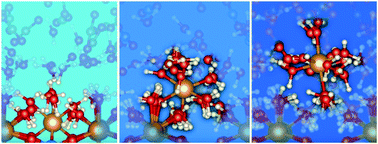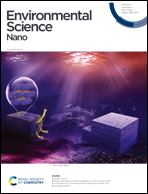Emerging investigator series: ion diffusivities in nanoconfined interfacial water films contribute to mineral carbonation thresholds†
Abstract
The dynamics and reactivity of nanoconfined fluids play critical roles across a wide range of environmental and technological systems, though reaction mechanisms and kinetics are not well understood. The carbonation kinetics of forsterite (Mg2SiO4) exposed to 90 atm supercritical carbon dioxide at 35–65 °C and 85–100% relative humidity (RH) was monitored with in situ X-ray diffraction, and partner molecular dynamics simulations were used to describe the free energy landscape of Mg2+ adsorption and diffusion on forsterite surfaces covered in water films 3–10 monolayers thick. The collective findings reveal how decreasing the water film thickness by ∼1.4 monolayers, from ∼0.92 to ∼0.64 nm, inhibited reaction rates by up to 97%, promoted anhydrous Mg-carbonate (magnesite, MgCO3) precipitation, and more than doubled the apparent activation energy of carbonation. The transport simulations suggest that four monolayers are required to enable sufficiently facile Mg2+ diffusion, helping explain previously observed water film thickness-dependent reactivity thresholds.

- This article is part of the themed collections: Best Papers of 2020 from RSC’s Environmental Science journals, Environmental Science: Nano Cover Art, Best Papers 2020 – Environmental Science: Nano and Emerging Investigators Series


 Please wait while we load your content...
Please wait while we load your content...
